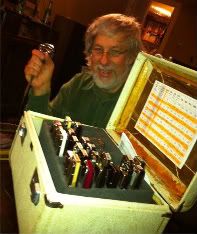|
Dirty-South Blues Harp forum: wail on! >
Proximity Effect vs. SPL handling
Proximity Effect vs. SPL handling
Page:
1
MrVerylongusername
1893 posts
Aug 25, 2011
4:43 AM

|
I've seen two or three threads about mics now, where it is clear that some posters are confusing the effects of tight cupping with proximity effect.
I read through Greg's brilliant primer on mics, and whilst it talks at length about overdriving an element by overwhelming it's sound pressure handling before distortion, it doesn't really discuss proximity effect at all.[*edit* proximity effect has very little to do with harp playing, so the fact that it isn't discussed in an article on harp mics isn't surprising.]
So I though I'd try my best to explain proximity effect to show how it is different from overdriving the element. Hopefully this will avoid some of the confusion in future.
This is how a directional (cardioid/supercardioid/hypercardioid) mic works:
The directional response is created by having rear ports on the cartridge - The sound entering through these rear port is delayed, fractionally, using foam (which filters a lot of HF stuff too) so that sound from the rear of the mic going through the rear ports hits the back of the diaphragm at the same time as any sound which travels around and hits the front - Equal pressure on front and back effectively cancel each other out, thus no sound pick-up fron the rear.
From a source in front of the mic though, the sound hits the front fractionally before the rear. It takes longer to travel the extra few mm between the front and the rear ports (and remember that damping material at the back too).
This pressure difference between the front and rear of the diaphragm - we'll call this the Gradient Component - is what drives the output of the mic. At long wavelength/low frequencies the pressure differences are smaller than those at short wavelength/high frequencies. In practice this means much greater sensitivity to high frequencies - the diaphragm must, therefore, be damped to those higher frequencies to give a more even response.
With me so far?
Ok, that'd be great if the sound pressure was constant, but it isn't. As the waves spread out from the source in all directions, the further from the source they get, the more the sound pressure dissipates (inverse square law).
The small distance from front to back of the diaphragm makes little difference to the pressure gradient at a close miking distance, but further back, the pressure gradient will be far more pronounced. This applies regardless of the frequency. We'll call this the Inverse Square component.
So we have two different components that act on a mic's diaphragm. At big distances the Inverse Square Component's effect is considerably less than the Gradient Component's and there is little coloration in the overall response. At close miking distances though, the inverse Square Component actually exceeds the Gradient Component at low frequencies.
This is the proximity effect: A boost to the low frequency response of cardioid/hypercardioid microphones at small distances.
Only directional dynamic mics have a proximity effect. Bullets, with crystal or CM/CR elements do not have a proximity effect - they cannot as the rear of their elements is sealed and they are driven by the front of their diaphragm alone. Worth saying too that proximity effect has nothing to do with impedance. Proximity effect is a phenomenon of a mic in free air and has nothing to do with cupping.
If you block the rear ports of a stick mic by cupping, the mic reverts to acting like a unidirectional mic - i.e. more like a bullet. There is no longer a frequency dependent gradient component - the response is based on direct sound pressure to the front alone - this effectively gives the bass response a big kick (much bigger than proximity effect does) Also, the air pressure build up as you blow into that tight cup and the semi vaccuum created when you draw, overwhelm the SPL handling of the cartridge - actually making the diaphragm travel further - and overdrives it.
Hope that helps the technical minded.
Last Edited by on Aug 25, 2011 6:34 AM
|
FreeWilly
20 posts
Aug 25, 2011
4:57 AM

|
Thanks Mr.V. Clears that one up for me!
|
Tuckster
871 posts
Aug 25, 2011
7:36 AM

|
I knew about the Proximity Effect,but I never knew why. Thanks Mr. V! My 585 has a pronounced Proximity Effect. I have to turn the bass tone 'way down or it gets too boomy.
Last Edited by on Aug 25, 2011 7:36 AM
|
bonedog569
378 posts
Aug 25, 2011
10:28 AM

|
Thanks for the cogent technical explanation. Having sung through 57's 58's and the like for years I am very familiar with proximity effect - but never knew how or why it worked - it just seemed 'natural' and I took it for granted.
I will be re-reading your post a time or two - to try and fully get it
Thanks again
----------

|
Post a Message
|